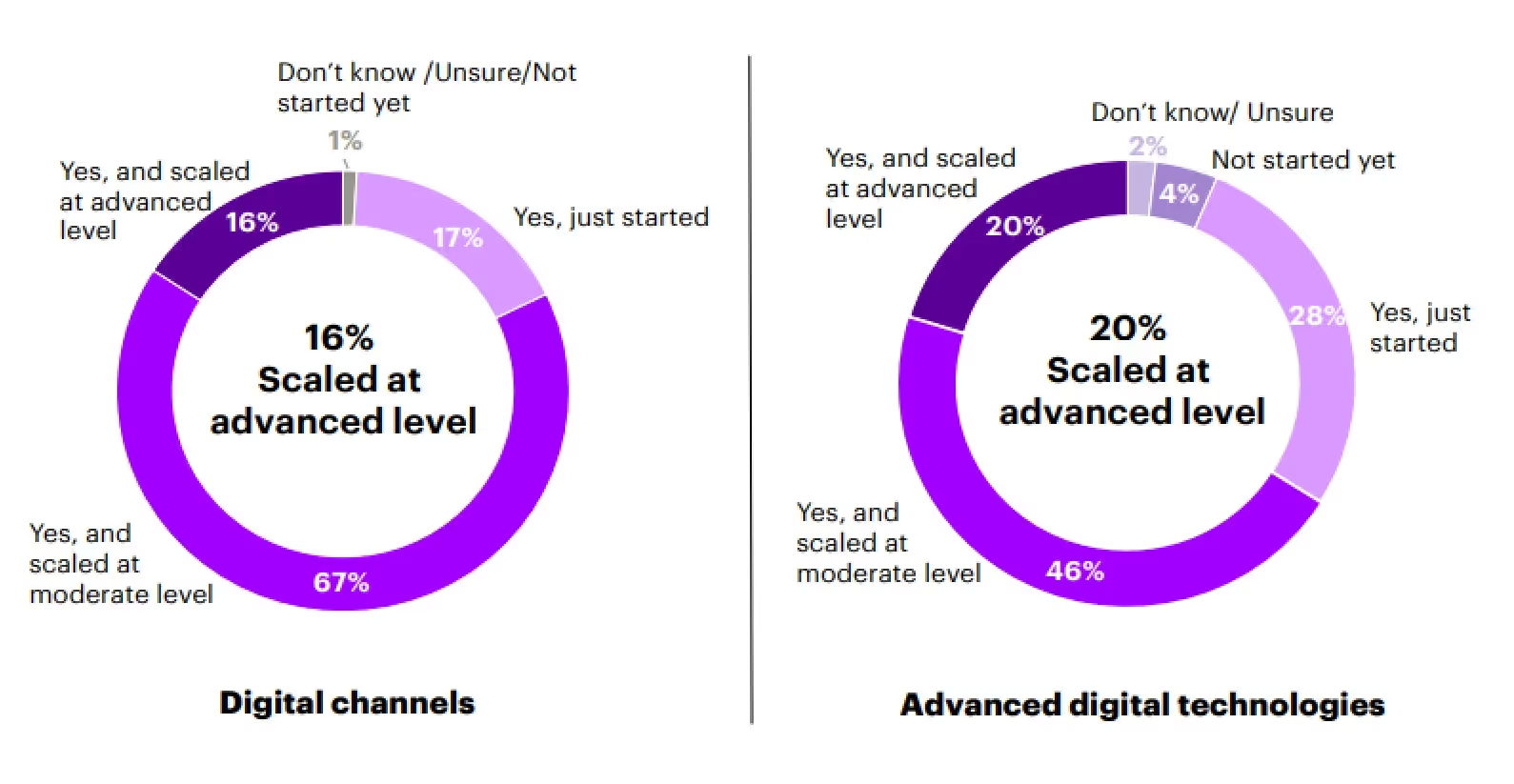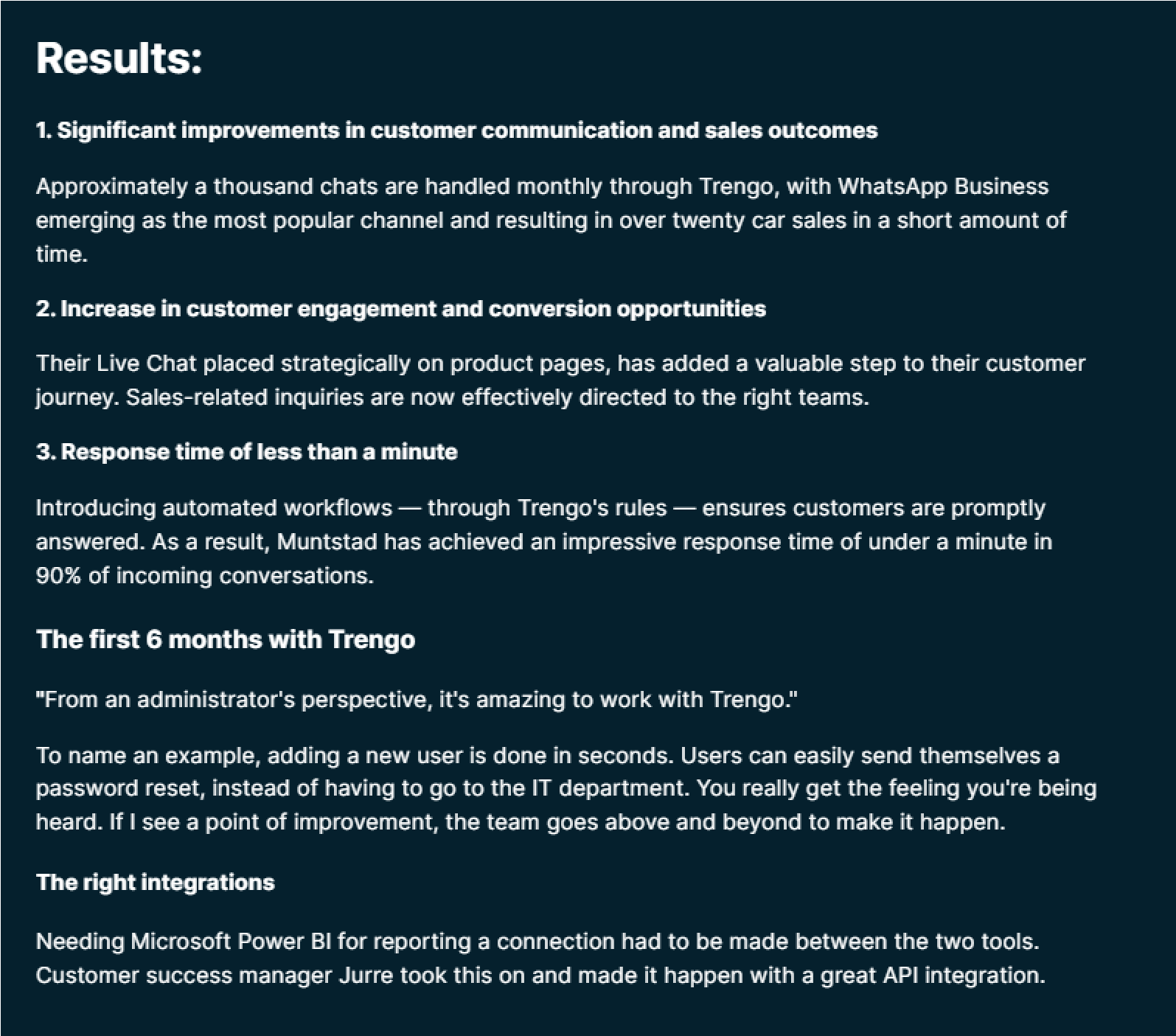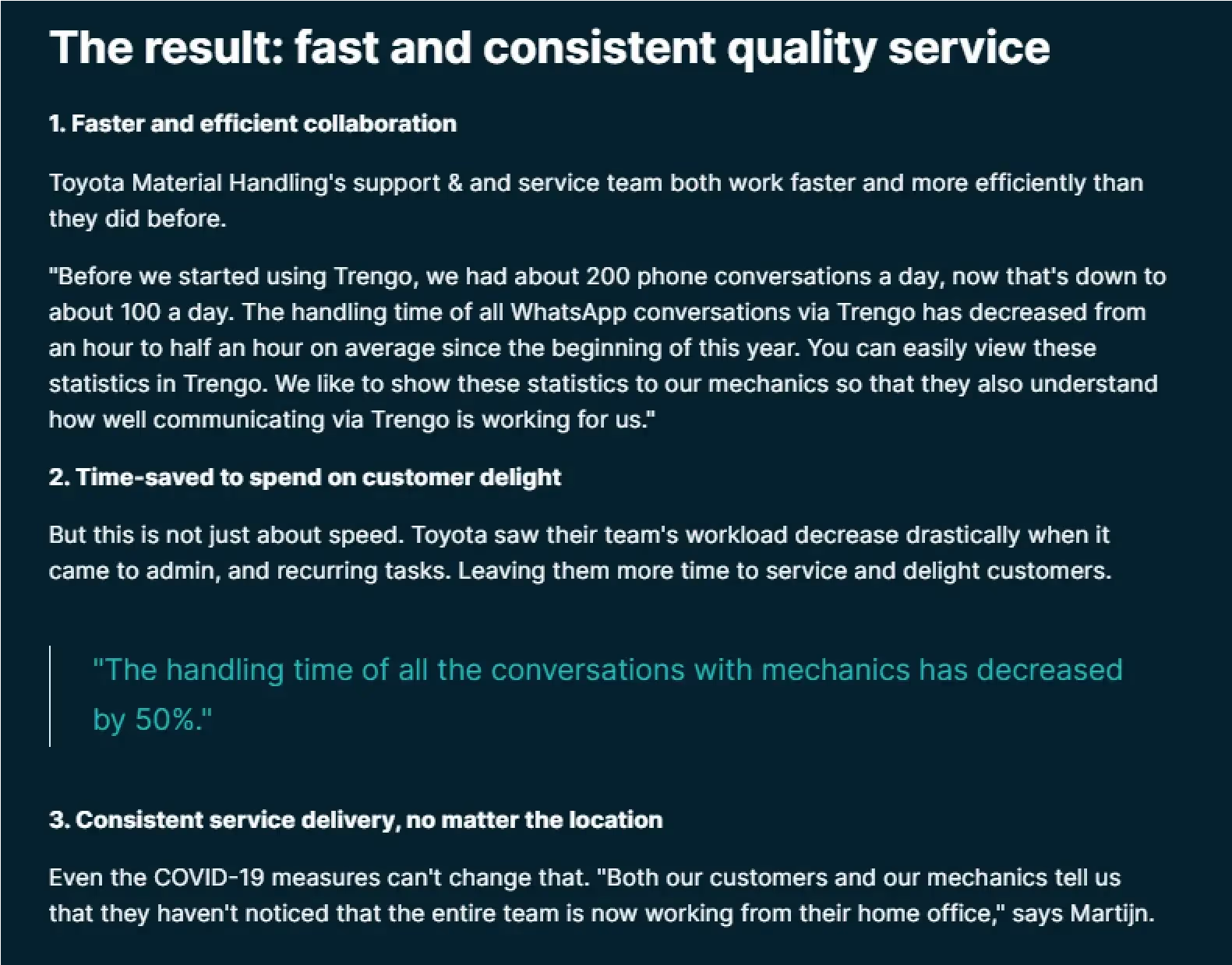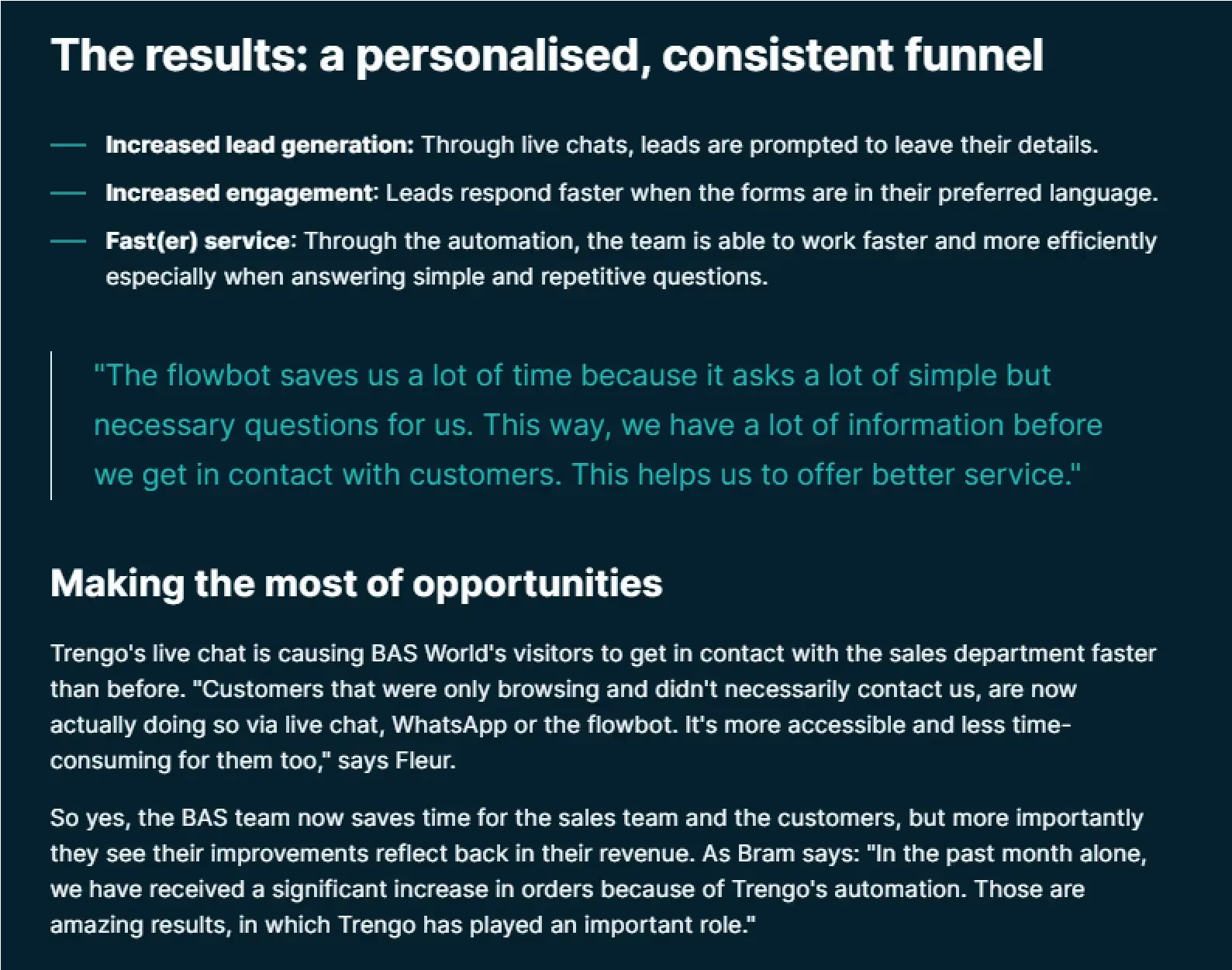Happy customers are the lifeblood of any business, and the automotive industry is no exception. In fact, it is even more important in the automotive industry, especially for dealers and manufacturers.
Nearly half of consumers agree that they find it difficult to know which automotive brands or companies to trust these days. Since buying a car is a big ticket purchase and a long-term investment, customers hold and remember any bad — or good — experiences for a long time.
So, how do you make sure that your customers pick you?
Together, let's go through the key challenges in automotive customer engagement and the benefits of implementing an effective automotive solution for customer engagement and tackle innovative strategies to build lasting relationships with your customers.
The automotive customer experience
68% of consumers agree that they rely on customer reviews (about dealers, manufacturers and service providers) to make informed decisions. Making it look as if the customers’ voice is more trusted than a brand’s own reputation.
The question now is, how can automotive businesses make an impact on their own reputation, and influence their reviews.
While the quality of the product is certainly the primary reason, much of what makes customers love a brand is about customer experience, as the following survey shows.

When we look at Data & Marketing Association research into why customers pick one car brand over the other we see that the top three quality is indeed first, while good service and helpful and welcoming attitude are second and third. Both pointing to customer experience, showing that this does weigh heavily on the decision-making process.
Key challenges in automotive customer engagement
Customers’ attitudes have evolved — what worked a decade ago may not work today. And engaging customers in the automotive industry requires focus and a big effort, mainly due to high value transactions.
Here are some of the roadblocks companies frequently encounter:
1. Standing out in a crowded marketplace
The automotive industry is fiercely competitive, with numerous brands — both manufacturers and dealerships — vying for customer attention. In this age of the Internet and information, it can be challenging to differentiate yourself and capture your customers’ interest. Traditional marketing tactics might get lost in the noise. In fact, even simply having a website isn’t enough anymore.
So what is?
💡Automation can be one of the answers. To give you an idea, dealers who use marketing automation are twice as likely to see a higher return on investment (ROI) for their marketing efforts compared to those who don’t. And speaking from the customer experience point of view, automotive brands that personalise CX can outperform the competition by as much as 40%.
2. Personalising the customer experience
Per Accenture, 66% of automotive customers demand personalised features and services, up from 54% three years ago. But the challenge? Only about half (55%) feel the experience they had visiting an automotive manufacturer’s website the last time they purchased a vehicle was personalised.
Generic marketing campaigns and one-size-fits-all approaches simply don’t resonate anymore. Customers crave a sense of connection and understanding, which can be difficult to achieve without leveraging data and insights effectively. This requires not just collecting data but also analysing it and using it to create targeted messaging, recommendations and offers that truly resonate with individual customers.
3. Providing real-time communication
Long wait times, sluggish response times and inefficient communication channels can damage the customer experience and leave customers feeling frustrated and unheard. In the automotive industry, it is quite a challenge. According to a study by Arthur D. Little, dealers’ average response time is 9.2 hours, while OEMs’ average time is around 24 hours.
It’s a lot(!), especially considering the expectations today’s customers have. Whether it’s a simple question about a car’s features or a complex service inquiry, customers want timely and efficient communication, ideally across multiple channels like phone, email and social media. And that can happen with a robust customer operations platform like Trengo.
4. Buying journeys are complex
The modern automotive buying journey is no longer a linear process, from browsing brochures to visiting a dealership. It’s a multi-layered “expedition” where customers navigate through various touchpoints, both online and offline. They start with online research (95% of car buyers, per Google), reading reviews and comparing features on different brand websites.
They might then visit a dealership for a test drive but continue researching and comparing options online before making a final decision. To address this challenge, brands need to simplify this journey, make information easily accessible across all touchpoints and facilitate informed decision-making.
5. Embracing digital transformation
While digital transformation presents significant opportunities for customer engagement, it also comes with challenges. For instance, a McKinsey study shows that almost 60 percent of potential car buyers under 45 would like to purchase their vehicle online. Even in the over-65 age category, 45 percent would consider buying online.
But the challenge? Only 16% of dealers believe they are using digital channels at a scaled level, and 20% believe they are using advanced technologies (such as big data analytics, AI, augmented and virtual reality and cloud) for CX at a scaled level.

Transitioning from traditional processes to a digital-first approach necessitates strategic partnerships with tech experts and a willingness to embrace change. This might involve building a robust online infrastructure (website, app, customer support platform) and implementing virtual showrooms and live chat functionalities.
6. Maintaining consistency across channels
In an omnichannel world, customers interact with brands through various touchpoints, including websites, social media platforms, email, Live Chat and in-person interactions. For example, a customer may find a car online on your website, ask about the offer through the Live Chat widget and follow up on social media.
Yet, only 11% of organisations claim to have a sophisticated omnichannel approach. Inconsistencies in messaging, brand identity or service quality across these channels can lead to confusion and dissatisfaction.
7. Meeting the evolving expectations of digitally savvy customers
Today’s digitally savvy customers have high expectations. They expect quick responses, personalised interactions and efficient services. They might be accustomed to the instant gratification and seamless experiences offered by other industries, and they expect the same from automotive brands.
But the problem? 1 in 2 car shoppers (52%, to be precise) feel anxious or uncomfortable at dealerships. 56% of millennials would rather clean their homes than negotiate with a car dealer. Gen X-ers aren’t fans either—24% of them say they’d rather have a root canal than get into car negotiation.
What many may not realise is that offering a better customer experience is not only for customers. It is for the business itself.
Benefits of customer engagement automotive solutions
Investing in effective customer engagement solutions is not only for the sake of customers; it brings significant benefits to your automotive business itself. Here are three key areas where you can see a positive impact:
Increased reach
Today, customers of all ages have access to information and options like never before. Fish where the fish are — you will find most of your customers online, on platforms such as Facebook, Twitter, TikTok and Instagram. Implementing customer engagement solutions — Live Chat, social media, targeted ads, email marketing—helps you navigate this crowded landscape and reach your target audience more effectively.
For instance, Statista sees that 78% of consumers discover new products or services through social media, especially Facebook. For some car categories, Instagram would make more sense; for some, TikTok. But if you ignore a channel, your potential customers may well overlook your brand altogether.
Enhanced lead generation
With reach comes leads — usually qualified leads. Effective customer engagement fosters genuine connections and builds trust with potential buyers. Personalised interactions, providing valuable content and addressing customer needs promptly can turn casual interest into qualified leads. These leads are more likely to convert into sales as they already have a positive perception of your brand and understand the value you offer.
A report by Twillio found that brands that have mastered customer engagement were 41% more likely to report their conversion rates as “much higher” compared to the previous year.
Stronger brand loyalty
86% of customers are willing to pay more for a great customer experience. Customer engagement solutions allow you to go beyond simply selling cars and, instead, create a community around your brand. Loyal customers not only pay more but are also more likely to recommend your brand to others and repeat their business with you. And brand loyalty comes with offering superior customer experiences—52% of customer-obsessed companies see improved loyalty and customer engagement.
Innovative automotive solutions for enhancing customer engagement
Where there is a challenge, there are opportunities. Customers crave interactive experiences and personalised connections and brands in the automotive industry can respond in kind.
Here are some innovative automotive solutions that can transform how you engage with your customers:
Digital showrooms and extended reality (XR)
Digital showrooms and virtual reality or augmented reality (collectively referred to as XR) technology allows customers to virtually experience different vehicle models, take 360-degree tours of interiors and even customise features. This immersive experience can spark excitement, generate early interest and inform purchase decisions. This is especially true amongst the young, with 60% of 18-34-year-olds interested in virtual or augmented reality to test drive or view cars.
Many brands, such as Tesla, Mercedes and BMW, already utilise a VR showroom experience that allows customers to explore their vehicles in stunning detail. And it is equally important for dealerships.
Mobile apps and connectivity
Smartphones are an extension of ourselves, and automotive apps can utilise this constant connection to enhance customer engagement. Among many things, an automotive app can:
- Check fuel levels, tire pressure and battery life remotely
- Deliver personalised recommendations for maintenance schedules or aftermarket parts
- Remind customers of upcoming service appointments
- Be used for fleet management
- Locate and schedule service for malfunctioning emission control systems
- Offer driving assistance
- Find empty parking slots
- Navigate your vehicle in a crowded space
For example, BMW’s ConnectedDrive app provides a suite of features, including remote vehicle diagnostics, personalised driving insights and even helps car owners locate their car in a crowded parking lot.
Social media and online communities
Brands and dealerships can use social media to enhance their brand’s presence. While large brands are already there, dealerships and car maintenance service centres can form their own online communities. To do that, you will have to build a customised social media strategy, which would depend upon the types of vehicles you sell (or repair) and the audience you target.
I recommend utilising all platforms. Start with Facebook—most of your audience is already here. Also, per Unified, auto ads have 2 times higher click-through rates than the average Facebook ad. If your target audience are millennials, be there at Instagram and Pinterest. And most importantly, do not forget video marketing—more than 40% of shoppers who watched a video about cars or trucks visited a dealer as a result.
Customer engagement management platforms (CEMPs)
CEMPs act as a central hub for managing customer data, preferences and interactions across all touchpoints. This allows manufacturers, dealerships and other service providers to personalise the customer journey and deliver a truly connected experience. A customer operations platform is the answer to most of the challenges we discussed above.
💡For instance, Trengo offers customised solutions for businesses in the automotive sector. It offers your customers an omnichannel experience — no matter the channel your customers use, you can see all the conversations in one place.
Unlike other customer engagement platforms, Trengo offers native integrations with WhatsApp Business and popular social media platforms. You can also automate your workflow, which further enhances your customer experience.

Here’s what businesses in the automotive sectors achieved using Trengo.
1. Muntstad
Munstand is a Netherlands-based automotive company that is one of the most well-known automotive companies in the country. Serving across 11 locations and catering to a large customer base, they experienced difficulties managing multiple customer communications across various channels. Their teams regularly encountered a high volume of incoming conversations on everything from sales and maintenance to standard repairs. However, given the lack of an integrated platform, the responses were rather slow and the overall customer experience was average.
Enter Trengo — and the results!

2. Toyota Material Handling
Toyota Material Handling is another automotive company that sells and rents out internal transport solutions, such as forklifts and pallet trucks. As part of offering a complete customer experience, they have their own service team, consisting of roughly 180 mechanics. On average, they received 347 requests a day.
“Before we started using Trengo, we used to communicate with our mechanics via phone. This created a high workload for our support teams and the processes in the field were often slowed down because of this,” says Martijn Kruijning, team lead support.
Here’s how they are doing after Trengo:

3. BAS World
BAS World is the biggest truck and trailer dealer in Europe. It sells used trucks, machines, vans, semi-trailers and even fire trucks. Every day, their sales team receives a lot of messages from businesses that want to either sell or buy vehicles.
“Because of the growing amount of daily inquiries of customers that speak a lot of different languages, we were struggling to reply to messages in a timely manner”, says Fleur van Heertum, sales employee at Bas World. “Besides that, there was always a possibility of missing out on leads because it wasn’t possible to contact us outside of business hours.”
For a complete solution — automated lead generation, chatbots, integrations and an omnichannel inbox—they chose Trengo. As a result, they experienced a 70% increase in leads and a 10% improvement in team efficiency.

Want to see how can we help you? Chat with Trengo's team, and customise an automotive solution for your needs.
Strategies for implementing effective customer engagement solutions
Simply having the right tools isn’t enough. To truly benefit from innovative customer engagement solutions, automotive companies need a strategic approach to their customer experience.
Here are four key strategies for successful implementation:
1. Data-driven insights
Never underrate customer data — it is a goldmine of information. You can have multiple avenues of customer data flowing — Google Analytics, social media analytics and insights, in-person feedback and the analytics within your customer engagement platform.
Leveraging analytics tools and utilising customer data responsibly allows you to:
- Understand customer needs: analyse data to identify customer pain points, preferences and buying journeys.
- Personalise the experience: tailor communication, promotions and recommendations based on individual customer data.
- Measure success: track key metrics to monitor the effectiveness of your engagement strategies and make adjustments as needed.
For example, dealerships might analyse website data to understand which car models generate the most interest. Service providers can see which type of customers are more likely to refer them to their friends and family. This data can then be used to target potential customers with relevant advertising campaigns and personalised offers.
2. Omnichannel communication
Today’s customers interact with brands through various channels, from websites and social media to dealerships and service centres. And they expect businesses to respond through all channels. At least 60% of customers expect consistent inputs through all channels, according to Deloitte.
To create a seamless experience, automotive companies need to ensure consistent and integrated communication across all touchpoints.
This would mean:
- Unified messaging: deliver a consistent brand voice and message across all communication channels.
- Seamless transitions: allow customers to easily shift between channels without losing context or needing to repeat information.
- Omnichannel support: offer customer support options across various platforms, such as phone, live chat and social media messaging.
For example, a customer might research a car online, schedule a test drive through a dealership app and then use social media to ask questions about the financing process. You know what may happen if there is a lackluster — or ignorant — response at any touchpoint.
3. Customer-centric culture
Building strong customer relationships requires a shift in mindset from top to bottom. And why should you? The stakes are otherwise high — 66% of consumers will abandon a brand if they don’t get a personalised experience.
Cultivate a company culture that prioritises customer service and satisfaction throughout the entire organisation. While tools definitely help, businesses need to:
- Empower their employees: train employees to deliver exceptional customer service and resolve issues effectively.
- Practice a proactive approach: anticipate customer needs and proactively address potential concerns.
- Implement a feedback loop: encourage customer feedback and actively seek ways to improve based on their input.
4. Continuous innovation and feedback loop
Technology and customer expectations are constantly evolving — and so should our approaches to customer experience and engagement. Be committed to continuous improvement and embrace a culture of innovation.
- Monitor industry trends: stay up-to-date on the latest customer engagement technologies and best practices. For example, extended reality (XR) or remote vehicle diagnostics are a couple of areas where innovation is happening in the automotive sector. But more is coming as well, for example, predictive customer support—and companies need to prepare.
- Adapt and experiment: be willing to experiment with new solutions and continuously refine your strategies based on results.
- Customer feedback loop: don’t shy away from your customers’ input about your business, even if it is negative. Actively solicit customer feedback and use it to identify areas for improvement and inform future innovation.
The right automotive solution for your customer engagement
The automotive industry is indeed undergoing a significant shift towards a more customer-centric future. It’s a reason excitement, not worry but businesses will have to adapt. Prioritising customer engagement and leveraging innovative solutions will help automotive companies build strong relationships that drive loyalty and growth. And the first step to becoming a customer-obsessed company is to invest in a fully integrated customer operations platform.




.png)











